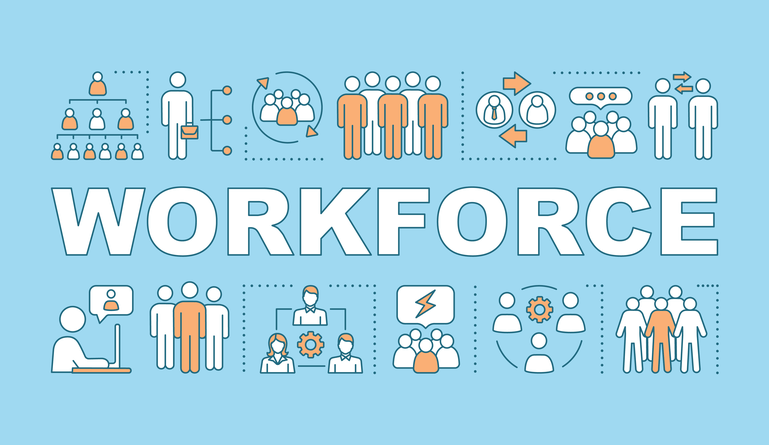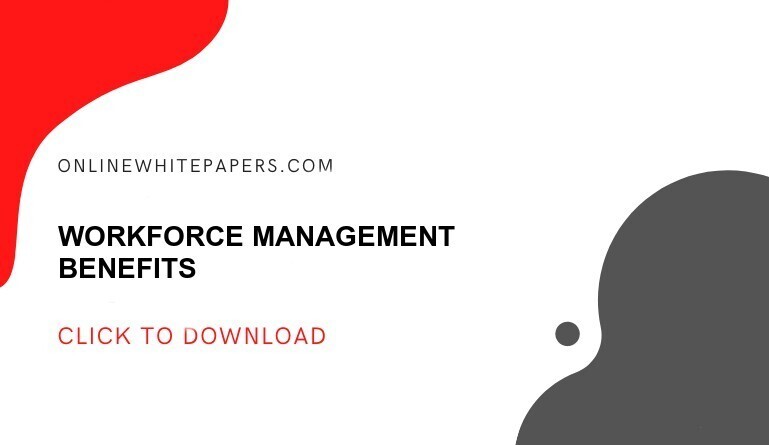The workforce trends are changes influenced by the prevailing circumstances that occur over time. Businesses can and should embrace workplace trends that boost productivity and employee engagement.
Sometimes it can be difficult to keep up with the newest model. A few years ago, employers were unconcerned with open offices, Friday lunches, standing desks, and unlimited paid time off.
While companies are accommodating these new trends an asteroid named COVID-19 collided with the real world and ushered in a fundamental change in the way we (and perhaps, our children) work. This disruption revamped the future of the workforce entirely.
A few of them are the amplified use of artificial intelligence, employee well-being, and the expansion of the workforce to include remote and hybrid workplace models.
( Also Read: Workforce Analytics – A Definitive Guide )
Here are 10 future workforce trends that are determining the future of work.
-
The surge of the Great Resignation
The ‘Great Resignation’ is a never-ending talent spike that has disrupted the demand-supply harmony, forcing organizations to prioritize both talent acquisition and retention.
Employer’s failure to empathize and respond to Covid-19 is not the only reason for widespread resignation. Other factors such as toxic culture and a reluctance to accept change contributed to burnout and reorganization. Additional factors such as job insecurity, unrecognized efforts of employees led to the Great Resignation.
Employees resigned at an all-time high in the second half of 2021, and more plan to do so in the coming year. According to a December ResumeBuilder.com poll of 1,250 American workers, approximately 23% of employees will seek new jobs in 2022, while 9% have already secured a new position.
According to data, many unemployed people are not rushing to fill open positions due to the absence of remote work options and a lack of visibility about career graphs.
As a result, many teams and organizations have made employee retention a top priority.
-
Remote and hybrid work environments take center stage
A remote job, also known as work from anywhere, is an employment arrangement in which employees are not required to travel to a central location for work, such as an office building, factory, or outlet.
In a hybrid-remote model, a fraction of the company workforce commutes to one or more offices on daily basis and works physically in the same space. This workforce cluster works in coordination with another fraction of the company workforce that works remotely. These organizations are primarily shared, and yet remote work is allowed.
According to an Owl Labs study(1), 16 percent of companies worldwide are fully remote. This study also discovered that 44 percent of companies do not allow any kind of remote work.63 percent of high-growth companies use hybrid work models.
According to the report, 63 percent of high-revenue growth companies are embracing productivity anywhere hybrid workforce models.
-
Use of AI and automation
The future of work and life will see greater progress and efficiency due to AI, automation, and machine learning. AI will make it easier for businesses to identify problems and deal with them more effectively. With AI it is envisaged that there will be significant improvements in recruitment, cybersecurity, marketing, and work processes.
Artificial intelligence is becoming responsible for everything from medical research breakthroughs to cutting-edge climate change research.
AI has grown in popularity because of its ability to process large amounts of data, execute complex algorithms, and apply advances in computing power and storage. AI will evolve to become smarter over time, increasing the efficiency of a business. AI will also reduce the likelihood of human error and analyze historical data to reduce costs.
-
Digital transformation of HR departments
HR is swinging between workloads and employee expectations as business variations have reset major work trends.
Companies are undergoing digital business transformations, which affect their products and services, operations, and internal capabilities. Automation and artificial intelligence are rapidly putting large segments of the labor market at risk of redundancy or radical change. These developments are drastically altering work and employment expectations.
Hence HR leadership is constantly re-evaluating manpower planning, emerging skills, the effects of artificial intelligence, the employee experience, and an array of factors affecting work and progress.
-
Prioritize continued employee growth
As more leaders prioritize workplace upskilling and reskilling, they hope to instill a growth mindset in their organization’s culture. They are emphasizing on overall employee development aspect.
In the future employees will actively seek opportunities to bind their impact and value in their work to share their experiences and accomplishments on social media.
Technology will identify when people have overworked themselves and when they need to recharge by monitoring their biorhythms, nutritional needs, and exercise requirements.
To enable continued employee growth and for a seamless transition through phases of employee life CEOs and HR leaders must collaborate to ensure work-life balance for each employee. This should be following their work distribution, time, and life stages change in order. Smart businesses provide their employees with the opportunity to make a positive social impact through their work.
-
Encourage diversity, inclusion, and equity
Diversity and inclusion (D&I) encompass factors beyond policies, schemes, and headcounts. Impartial employers outperform their competitors by respecting every team member’s unique requirement, viewpoints, and potential. As a result, workplaces that are diverse and inclusive earn greater trust and commitment from their employees.
Pay equity must be promoted by the employer. Managers must set fair competition and ensure equal opportunity for all employees. Analytics can help organizations identify which employees are underpaid for similar roles or responsibilities.
Employees benefit from diversity training where they understand how cultural differences affect the way people work and interact at work.
-
Higher preference for employee well-being
Employee well-being would be given preference by providing additional employee benefits, greater flexibility, sign-on bonuses, and an overall positive workplace experience.
If the pandemic continues, it will increase stress and burnout. Therefore, companies are increasingly focusing on work-life balance and employee mental health. During the pandemic, organizations used this emphasis on the “whole employee” to attract and retain talent. The whole employee is a term to describe that you are acknowledging that what happens in one part of a person’s life affects every other part of their life by mentioning their health, well-being, and performance. In this context, according to one PwC survey(2), 44 percent of organizations have increased paid time off and wellness programs for their employees.
-
Increased organizational talent shortages
People are taking breaks, distancing themselves from employers, and turning to freelance to avoid burnout. Many industries’ skill requirements are changing. In addition, nearly 7 in 10 companies worldwide reported talent shortages and hiring difficulties in 2021,(3) which is a 15-year high.
As a result, retraining existing employees to fill internal positions has become one solution for employers. Reskilling prepares existing employees to take on new responsibilities within the organization. This enables the company to respond to the changing requirements. A reskilled workforce can maximize their potential in their current roles or take on new tasks where the business requires assistance. Companies can only survive in these times with a workforce that is adaptable, agile, and eager to learn.
-
Upskill on skills over tasks
Leaders understand that focusing on employee upskilling and career pathing can help their organizations close skills gaps. This entails employing a completely new set of tools to identify individual skill sets, as opposed to more traditional job grading methods. Skills development can assist organizations in meeting their most pressing business needs.
Global research analyst Josh Bersin writes in his report “HR Predictions for 2022” that in the past, companies saw employee training as important but not necessarily as a competitive advantage. This is rapidly changing as a result of digitalization and automation.
-
Soft skills required
The need to build relationships virtually and work with less oversight has increased the importance of soft skills in the workplace.
Bersin predicts in his report that organizations’ emphasis on these skills will grow. Companies will rethink their leadership models and the skills required for leaders to succeed in their ventures.
It has numerous advantages, including assisting the employer to recognize how their employees will interact with peers. It is an indicator of how they embrace change, how they respond to situations, understanding why someone feels a certain way, and so on. Emotional intelligence essentially facilitates the formation of connections and collaboration with others.
Final Thought
So, as a result of the pandemic companies and consumers must quickly adopt new trends that are likely to stick for a longer period. As a result, there is a notable change in their impact on labor markets before and after the pandemic.
Workforce trends accrue with the working environment over time. As increased connectivity, robotics, and cognitive tools modify the nature of work. Besides this, new talent search and the collaborative economy are reshaping the workforce. Now seems to be the moment to reinterpret where, and how work is done to open up the boundless energy and possibilities of human potential.








